| FieldGuidetoQuilts.com |
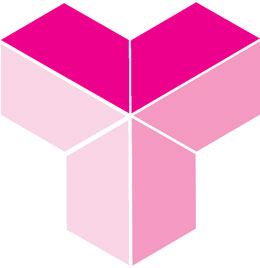 One-patch, continuous, and border blocks One-patch, continuous, and border blocks
|
These blocks are either
• one-patches, meaning that only one shape is used for the quilt
• border blocks, or
• continuous blocks, which end in something other than a straight edge.
Clam Shells Clam Shells KCS, 1932 Shell Chain/Clam Shell/The Cam Shell Quilt/The Shell/Shell Quilting It's not the oldest name, but Clam Shells is the one that stuck to this one-patch block. It's from a 1932 Kansas City Star. Clam Shells was first published as Shell Chain in the 1897 Ladies Art Company catalog (#62). Ruth Finley, in her Old Patchwork Quilts (1929), called it Clam Shell. The rest of the block names -- from Home Art Studios, Q Book 130, and Nancy Page -- came along from 1933 to 1941. For details, check out Jinny Beyer's The Quilter's Album of Patchwork Patterns (2009). We haven't named a tutorial for making the block; they're easy to find on the web. We've posted a diagram, though. Click on the Make It! icon to see it. |
 Clam Shells Clam Shells |
|
Apple Core |
 Apple Core | |
Thousand Pyramids
|
 Thousand Pyramids Thousand Pyramids |
|
The Mowing Machine |
 The Mowing Machine Quilt |
|
Ocean Waves border Ocean Waves Ocean WavesLadies Art Co., #182, 1897 The Ladies Art Company published Ocean Waves as #182 in 1897. The block was always intended as a border; the illustration showed ragged edges on each side of the block, and the finished size (if you bought the pattern) was six inches by twelve. It's basically a grid of right isosceles triangles in two colors. There is an Ocean Waves block pattern that puts this motif into an O. Click here to see: The border block, however, was always intended to be a border. |
Ocean Waves border |
|
Shadows border Shadows ShadowsHall, 1935 Carrie Hall, quilt researcher, stitched up one of these blocks for her collection of block designs, now at the Spencer Museum of Art at the University of Kansas. Hall collected the designs in the 1930s. To show it as a border block, Hall's example was three triangles wide and two triangles tall. |
Shadows border |
                Shadows |
Tumbler
|
 Tumbler |
|
The Tumbler |
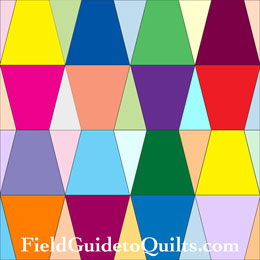         Tumbler (Finley) |
|
|
||
Rail-Fence border |
|
|
The World Fair Quilt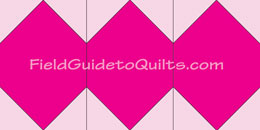 The World Fair Quilt KCS, 1943 The Kansas City Star published The World [sic] Fair Quilt in 1943. The Star didn't show it as a border block, but it's so well suited for one that we thought it belonged here. We've reversed the dark and light colors to show the seams. |
The World Fair Quilt |
|
The Picket Fence QuiltThe Picket Fence Quilt KCS, 1954 Like The World Fair Quilt, The Picket Fence Quilt is an ideal border block, although it was not published as one. When The Kansas City Star's Weekly Edition published it in 1954, the illustration didn't match the pattern piece printed along with it. The block at at top left is based on the pattern. The block at bottom left is based on the illustration. The Star pointed out that two settings were possible, one horizontal, the other vertical. |       Picket Fence pattern: The legs are three times as long as they are wide. |
    Picket Fence illustration: The legs are twice as long as they are wide. |
The Rope Strands |
                The Rope Strands |
Above, as a border block. |
Right Angles Patchwork
|
 Right Angles Patchwork Right Angles Patchwork |
|
Inner City Inner City Beyer, 1977 At left is a single Inner City block and the half-hexagon pieces that create it. The name is from Jinny Beyer's Patchwork Patterns (1977). The name Windy City appears without citation in Maggie Malone's 5,500 Quilt Block Designs (2003). The dark, medium, and light colors need to be placed as they are in the graphic for the block's overall effect to work. |
 Inner City Inner City |
|
Crazy Tile Quilt |
 Crazy Tile Quilt Crazy Tile Quilt |
|
Ecclesiastical Ecclesiastical Ladies Art Co., 1897 In any case, it makes for an elegant whole quilt made entirely of half-hexagons. |
 Ecclesiastical Ecclesiastical |
|
 |
||


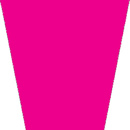



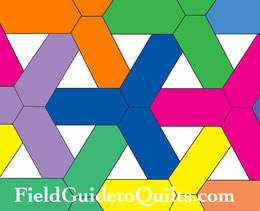

 Thousand Pyramids
Thousand Pyramids 

 Ribbon Border
Ribbon Border

 The Rope Strands
The Rope Strands